#Horse Care
Explore tagged Tumblr posts
Text
Preindustrial travel, and long explanations on why different distances are like that
Update March 1, 2024: Hey there folks, here's yet another update! I reposted Part 2a (the "medieval warhorses" tangent) to my writing blog, and I went down MORE of the horse-knowledge rabbit hole! https://www.tumblr.com/jadevine/741423906984951808/my-post-got-cut-off-so-i-added-the-rest-of-it Update Jan 30, 2024: Hey folks, I've posted the updated version of this post on my blog, so I don't have to keep frantically telling everyone "hey, that's the old version of this post!" https://thebalangay.wordpress.com/2024/01/29/preindustrial-travel-times-part-1/
I should get the posts about army travel times and camp followers reformatted and posted to my blog around the end of the week, so I'll filter through my extremely tangled thread for them.
Part 2 - Preindustrial ARMY travel times: https://www.tumblr.com/jadevine/739342239113871360/now-for-a-key-aspect-that-many-people-often-ask
Part 2a - How realistic warhorses look and act, because the myth of "all knights were mounted on huge clunky draft horses" just refuses to die: https://www.tumblr.com/jadevine/732043691180605440/helpful-things-for-action-writers-to-remember
Part 3 - Additional note about camp followers being regular workers AND sex-workers: https://www.tumblr.com/jadevine/740604203134828544/reblogging-the-time-looped-version-of-my
--
I saw a post on my main blog about how hiking groups need to keep pace with their slowest member, but many hikers mistakenly think that the point of hiking is "get from Point A to Point B as fast as possible" instead of "spending time outdoors in nature with friends," and then they complain that a new/less-experienced/sick/disabled hiker is spoiling their time-frame by constantly needing breaks, or huffing and puffing to catch up.
I run into a related question of "how long does it take to travel from Point A to Point B on horseback?" a lot, as a fantasy writer who wants to be SEMI-realistic; in the Western world at least, our post-industrial minds have largely forgotten what it's like to travel, both on our own feet and in groups.
People ask the new writer, "well, who in your cast is traveling? Is getting to Point B an emergency or not? What time of year is it?", and the newbies often get confused as to why they need so much information for "travel times." Maybe new writers see lists of "preindustrial travel times" like a primitive version of Google Maps, where all you need to do is plug in Point A and Point B.
But see, Google Maps DOES account for traveling delays, like different routes, constructions, accidents, and weather; you as the person will also need to figure in whether you're driving a car versus taking a bus/train, and so you'll need to figure out parking time or waiting time for the bus/train to actually GET THERE.
The difference between us and preindustrial travelers is that 1) we can outsource the calculations now, 2) we often travel for FUN instead of necessity.
The general rule of thumb for preindustrial times is that a healthy and prime-aged adult on foot, or a rider/horse pair of fit and prime-aged adults, can usually make 20-30 miles per day, in fair weather and on good terrain.
Why is this so specific? Because not everyone in preindustrial times was fit, not everyone was healthy, not everyone was between the ages of 20-35ish, and not everyone had nice clear skies and good terrain to travel on.
If you are too far below 18 years old or too far past 40, at best you will need either a slower pace or more frequent breaks to cover the same distance, and at worst you'll cut the travel distance in half to 10 or so miles. Too much walking is VERY BAD on too-young/old knees, and teenagers or very short adults may just have short legs even if they're fine with 8-10 hours of actual walking. Young children may get sick of walking and pitch a fit because THEY'RE TIREDDDDDDDDDD, and then you might need to stay put while they cry it out, or an adult may sigh and haul them over their shoulder (and therefore be weighed down by about 50lbs of Angry Child).
Heavy forests, wetlands and rocky hills/mountains are also going to be a much shorter "distance" per day. For forests or wetlands, you have to account for a lot of villagers going "who's gonna cut down acres of trees for one road? NOT ME," or "who's gonna drain acres of swamp for one road? NOT ME." Mountainous regions have their traveling time eaten by going UP, or finding a safer path that goes AROUND, so by the time you're done slogging through drier patches of wetlands or squeezing through trees, a deceptively short 10-15 miles in rough terrain might take you a whole day to walk instead of the usual half-day.
If you are traveling in freezing winters or during a rainstorm (and this inherently means you HAVE NO CHOICE, because nobody in preindustrial times would travel in bad weather if they could help it), you run the high risk of losing your way and then dying of exposure or slipping and breaking your neck, just a few miles out of the town/village.
Traveling in TOO-HOT weather is just as bad, because pushing yourself too hard and getting dehydrated at noon in the tropics will literally kill you. It's called heat-STROKE, not "heat-PARTY."
And now for the upper range of "traveling on horseback!"
Fully mounted groups can usually make 30-40 miles per day between Point A and Point B, but I find there are two unspoken requirements: "Point B must have enough food for all those people and horses," and "the mounted party DOESN'T need to keep pace with foot soldiers, camp followers, or supply wagons."
This means your mounted party would be traveling to 1) a rendezvous point like an ally's camp or a noble's castle, or 2) a town/city with plenty of inns. Maybe they're not literally going 30-40 miles in one trip, but they're scouting the area for 15-20 miles and then returning to their main group. Perhaps they'd be going to an allied village, but even a relatively small group of 10-20 warhorses will need 10-20 pounds of grain EACH and 20-30 pounds of hay EACH. 100-400 pounds of grain and 200-600 pounds of hay for the horses alone means that you need to stash supplies at the village beforehand, or the village needs to be a very large/prosperous one to have a guaranteed large surplus of food.
A dead sprint of 50-60 miles per day is possible for a preindustrial mounted pair, IF YOU REALLY, REALLY HAVE TO. Moreover, that is for ONE day. Many articles agree that 40 miles per day is already a hard ride, so 50-60 miles is REALLY pushing the envelope on horse and rider limits.
NOTE: While modern-day endurance rides routinely go for 50-100 miles in one day, remember that a preindustrial rider will not have the medical/logistical support that a modern endurance rider and their horse does.
If you say "they went fifty miles in a day" in most preindustrial times, the horse and rider's bodies will get wrecked. Either the person, their horse, or both, risk dying of exhaustion or getting disabled from the strain.
Whether you and your horse are fit enough to handle it and "only" have several days of defenselessness from severe pain/fatigue (and thus rely on family/friends to help you out), or you die as a heroic sacrifice, or you aren't QUITE fit enough and become disabled, or you get flat-out saved by magic or another rider who volunteers to go the other half, going past 40 miles in a day is a "Gondor Calls For Aid" level of emergency.
As a writer, I feel this kind of feat should be placed VERY carefully in a story: Either at the beginning to kick the plot off, at the climax to turn the tide, or at the end.
Preindustrial people were people--some treated their horses as tools/vehicles, and didn't care if they were killed or disabled by pushing them to their limits, but others very much cared for their horses. They needed to keep them in working condition for about 15-20 years, and they would not dream of doing this without a VERY good reason.
—
UPDATE January 13: Several people have gotten curious and looked at maps, to find out how a lot of cities are indeed spread out at a nice distance of 20-30 miles apart! I love getting people interested in my hyperfixations, lol.
But remember that this is the space between CITIES AND TOWNS. There should never be a 20-mile stretch of empty wilderness between City A and Town B, unless your world explains why folks are able to build a city in the middle of nowhere, or if something has specifically gone wrong to wipe out its supporting villages!
Period pieces often portray a shining city rising from a sea of picturesque empty land, without a single grain field or cow pasture in sight, but that city would starve to death very quickly in preindustrial times.
Why? Because as Bret Devereaux mentions in his “Lonely Cities” article (https://acoup.blog/2019/07/12/collections-the-lonely-city-part-i-the-ideal-city/), preindustrial cities and towns must have nearby villages (and even smaller towns, if large and prosperous enough!) to grow their food for them.
The settlements around a city will usually be scattered a few miles apart from each other, usually clustered along the roads to the city gates. Those villages and towns at the halfway point between cities (say 10-15 miles) are going to be essential stops for older/sick folks, merchants with cargo, and large groups like noble’s retinues and army forces.
Preindustrial armies and large noble retinues usually can’t make it far past 10-12 miles per day, as denoted in my addition to this post. (https://www.tumblr.com/jadevine/739342239113871360/now-for-a-key-aspect-that-many-people-often-ask )
7K notes
·
View notes
Text
Hyperkalemic Periodic Paralysis (HYPP)
Breeds with HYPP; Quarter Horses, American Paint Horses, Appaloosas, and Quarter Horse Crosses.
HYPP
"An inherited disease of the muscle, caused by a genetic defect. A mutation in the sodium channel gene. Sodium channels are pores in the muscle cell membrane which control contraction of the muscle fibers. When the defective sodium channel gene is present, the channel becomes “leaky” and makes the muscle overly excitable and contract involuntarily. The channel become “leaky” when potassium levels fluctuate in the blood. This may occur with fasting followed by consumption of a high potassium feed such as alfalfa. Hyperkalemia, which is an excessive amount of potassium in the blood, causes the muscles in the horse to contract more readily than normal. This makes the horse susceptible to sporadic episodes of muscle tremors or paralysis."
GENOTYPE
HYPP Positive= H/N and H/H
HYPP Negative= HYPP N/N
HYPP horses with H/N genotype means they are heterozygous carriers, carrying one copy of the HYPP gene. If you bred a mare who is H/N to a stallion who is N/N, you would have about a 50% chance the foal is H/N as well. However if you bred an H/N mare to an H/N stallion you will have about a 25% chance the foal being N/N, a 50% chance it will be H/N, and a 25% chance it will be H/H.
HYPP horses with the H/H genotype means it is homozygous, carrying both copies of the HYPP gene. 100% passing the HYPP gene to it's offspring.
I made a thing in case it helps the visual learners out there
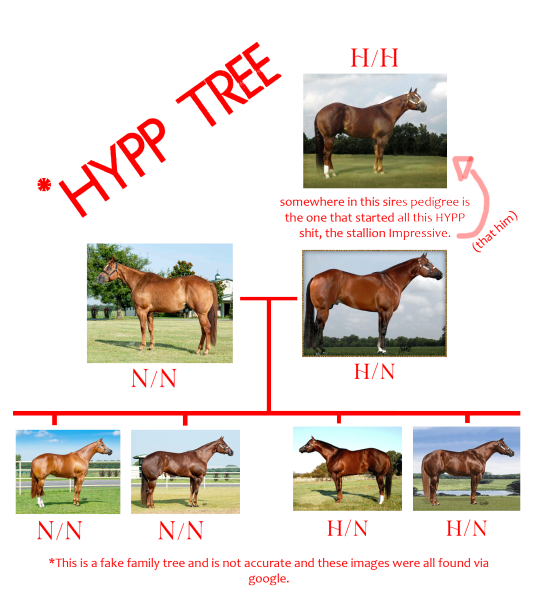
IMPRESSIVE (but not really)
Let's talk about the QH stallion, Impressive. All horses that have a HYPP positive gene of any kind, all descend from this horse. Impressive sired 2,250 foals and they estimate he has around 50,000 living descendants. No dilution of lineage will remove HYPP, as it is a dominant trait and will show whether you are 5 generations back or 2.
HYPP SYMPTOMS
HYPP varies in severity, it's not always equal and every horse may have different reactions. HYPP can be confused for tying-up or even colic, they may have difficulty breathing, muscle tremors, sweating, weakness, tremors. In more severe cases the horse may collapse from paralysis of the muscles in the airway and can result in sudden death.
Not every horse who is HYPP positive may display symptoms, making this disease sometimes hard to detect.
IS IT CURABLE?
No. HYPP may be managed with diet and certain medicines for maintenance but it cannot be cured. H/H positive horses have poor prognosis and can be much more difficult to manage.
VIDEOS OF HYPP ATTACKS
CW: Horses in distress, videos may be hard to watch for some.
Video 1
Video 2
Video 3
Video 4
Video 5
Sources (and if you want to read more); AAEP , UCDavis, Tri-State
Is there anything I forgot? Anything to add? Just covering the basics of this disease and what it does to these horses.
251 notes
·
View notes
Photo

Markham's Masterpiece of Horse Care
123 notes
·
View notes
Text
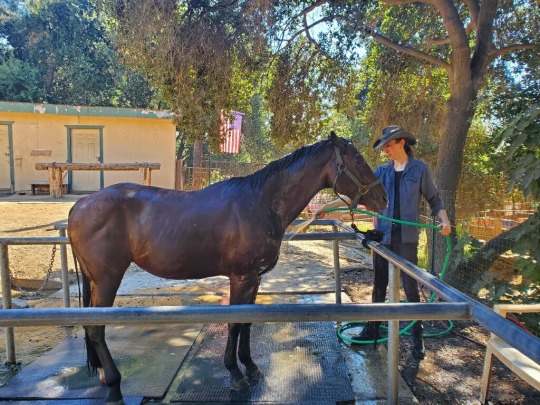
Whiskey got a full shampoo and condition.
113 notes
·
View notes
Note
Hey! I hope you are having a great day!
I have some wordbuilding question about horses.
First off, what makes a horse good for endurance riding, riding in general especialy in colder enviroments. How does a horse like that look anatomy wise? I have a mighty need to give my characters big fluffy horses with long manes and feathered feet because i am not immune to the hollywood horse propaganda but it is my understanding that that is not the right horse for what i need it to do.
Also how do you care for a horse and yourself after a long and exhausting ride ? What are the absolutely esential, non negotiabel steps. I have a high speed long distance chase with horses and the resources awailibel are not ideal. In terms of technology its around late medival.
Sorry for the long/complicated ask. I understand if you can't/don't want to answer.
Hi! How delightful and thank you for asking!
What makes a horse good for endurance does differ a bit from hot to cold environments, but the basic tenet is a compact body shape, efficient food consumption, and sturdy limbs. Cold environments also breed horses with shorter leg to body ratio, and long, shaggy coats. So fluffy yes, big no.

This is an Icelandic Horse, a breed native to Iceland, and descended from Viking horses. These ponies are efficient, sturdy, and have a special gait called the Tölt, a fast pace that is very smooth and comfortable to ride for long distances. A similar breed is the Fjord, though they lack the Tölt gait.

Now, as for a long and exhausting chase, there are a few non-negotiables. First, top speed of humans and horses can only be maintained for a few minutes at most. Endurance riders spend most of their ride in the trot, which is the most stable of the gaits and the easiest to maintain for long distances, save for a special gait like the Tölt. Second, if speed must be maintained over saving the horse's endurance, riders will trade off horses, such as with the Pony Express, where riders continued at high speeds, but transferred horses every few hours. If endurance is more important than speed, or no other horses available, riders will often dismount and jog alongside their horses for a time, to let the horse recover from carrying them. Riders over long distances will often have two horses or more in a 'string', and will have one horse carrying pack items, such as tents, food, weapons, ect, and one horse for riding. These can be switched around, or a horse left behind if it cannot keep up.
And most importantly for a cold scenario, horses and humans both sweat through their skin. This is extremely dangerous, as the cold can quickly cause shakes, cramps, and hypothermia if not properly cooled down. The way to do this is by draping a horse blanket, preferably wool for best moisture wicking, over the horse's body and walking the horse until heat and sweat has evaporated. After a long ride, this can take extra hours, but without this care, humans and horses can die. Once the sweat has evaporated and the horse is cool to the touch, the salt then needs to be groomed off with a brush or curry comb.

The horse should also then receive plenty of water, and if possible, a warm soaked mash, to further hydrate them. In the medieval period, horse bread, a baked bread make of nuts, oats, and grain, would be soaked in warm water and fed to the horse. It is also important to provide a source of salt, as much if it would have been sweated out, but this would also often be in the horse bread anyway. After a very hard ride however, a salt block or loose salt may be put in a bucket if the horse wants it. Again, without salt, the animal and humans will die.
Horse-bread Recipe
In the days after such a ride, the horse and rider should have plenty of rest, water, and food. They will be sore and tired, and possibly have injuries. Minor scrapes, hoof bruises, a pulled muscle, torn off horse shoes, and even a burst blood vessel in the nostrils can all happen during a hard ride. (the blood vessel will make it look like the horse is bleeding from its lungs, which is a deadly sign. However, if its just a minor blood vessel, the horse will be fine despite looking grisly.)
Hope I answered all your questions satisfactorily, and thank you for asking! Feel free to ask follow ups if need be!
#equestrian#horse information post#horses#how to write horses#writing advice#worldbuilding#chase scenes#horse care
19 notes
·
View notes
Text
Herbert is hurtin’ and there go my plans to upgrade my 2016 computer. 💸💸💸💸 you never have a budget for anything else when you have an old horse. Vet thinks he can recover just fine with all the meds I just bought.
10 notes
·
View notes
Text
How to take care of a horse. 🐴🤎🚿
📹: khayli.ma
10 notes
·
View notes
Text


We are currently reseeding and rotating/resting pastures for the winter at the farm. They do a really nice job with this, honestly. I’m impressed!
#equestrian#horse#horses#horse back riding#thoroughbred#ottb#equine#florida winter#florida#florida farm#horse farm#reseeding#farm life#horse care#horse pasture
2 notes
·
View notes
Text






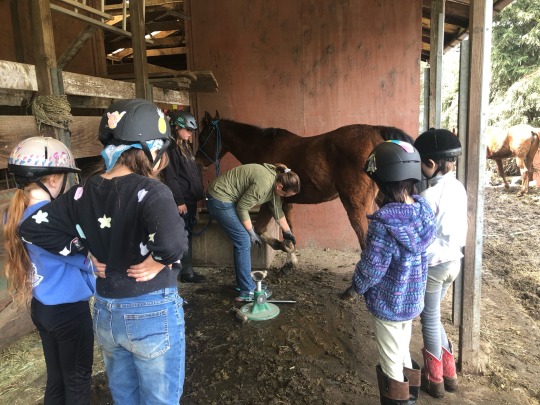

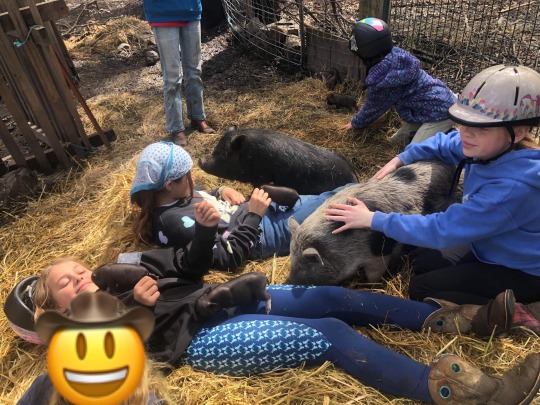
Spring break program 2023 ❤️ A great farrowing this spring! We love our sows
#animals#horses#babyanimals#bay horses#california#horse care#horse lessons#horse riding#kidsridinghorses#mares#ranch#redwoods#rescue horses#trailriding#ranching#goat#pinto horse#horse girl#farmlife#ranchlifestyle#minihorse#horse property
4 notes
·
View notes
Text

Horse N Tale’s complete topical product range covers a wide and varied variety of equine aliments, maintenance needs and parts of the body:
* Behavior issues
* Regular grooming
* Hoof protection
* Pain management
* Respiratory problems
* Skin complaints
* Stomach upsets
* Wound care
Natural ingredients as nature intended.
Order today your equine athlete will thank you.
#equine#horse#horse n tale#horse talk#natural equine products#natural products#horse n tale natural products#botanical products#natural horse products#natural horse care#horse trainer#horse care#horselover#horse products#horse product#barrel horse#horse girl#horse racing#horses#horseback riding#natural horse care products#horses of tumblr#horsesofinstagram#horse health#my horse#equine athletes#equines#equine athlete#equine product#equine products
2 notes
·
View notes
Text




maybe never forgive. but things are different now. so we'll use maybe.
#my version of a happy ending au#mouthwashing#captain curly#mouthwashing anya#anya#curly#my art#considering this game takes place in a hellscape#i imagine one of the other horrifying angles for anya was that she might not even have the rights to abort the wound#so i like to think. curly. thinking he's going to die anyway. just takes all of the medical bills from his crew#because if he lives then he'll spend his life paying it all off#and if he dies. then he takes the burden with him#but him and anya are horrible horrible parallels now. and they cant NOT care about each other#he'll turn himself into the horse. he'll be the beast of burden. anything he said. anything#and for once he actually means it.
25K notes
·
View notes
Text

Strength, speed, and a whole lot of love!
This Valentine’s Day, give your horse the ultimate gift—health & care with Venttura’s premium supplements. Because true love is keeping them galloping strong! 🐴❤️
shop now click the link below
0 notes
Text
Ughhhh blanketing in the spring is SUCH a pain... have to put layers on after work tomorrow, then send Mom to take off the heavy on Thursday bc I can't go to the barn at noon on a work day, then switch back to the heavy (but not layers) overnight and send Mom again on Friday to take it off completely... why can't the weather just be stable?? 😑
#this is why spring is my least favorite season. i barely know what coat to put on MYSELF bc it changes EVERY FREAKINH HOUR#but i cant be at the barn to change horse blankets every hour so just gotta PREDICT THE FUTURE I GUESS#horses#horsemanship#horse care#horse blanket#i use words
0 notes
Text

Comfort and mobility are essential for a fulfilling life, whether it involves humans, horses, or dogs. For those who prioritize the well-being of themselves and their beloved pets, finding a natural solution to ease joint discomfort is paramount.
Rose-Hip Vital is a special supplement made to help keep your joints healthy.
In this article, we will delve into its numerous advantages and investigate how it can benefit the joint health of different species, including humans, horses, and dogs. .....
#Joint Health#Rose-Hip Vital#Natural Supplements#Anti-Inflammatory#Mobility#Pet Wellness#Horse Care#Dog Health#Arthritis Relief#Cartilage Support#Vitamin C#Equine Health#Canine Joint Support#Natural Remedies#Health Benefits#Antioxidants#Holistic Health#Senior Dogs#Active Lifestyle#Wellness for Pets
1 note
·
View note
Text

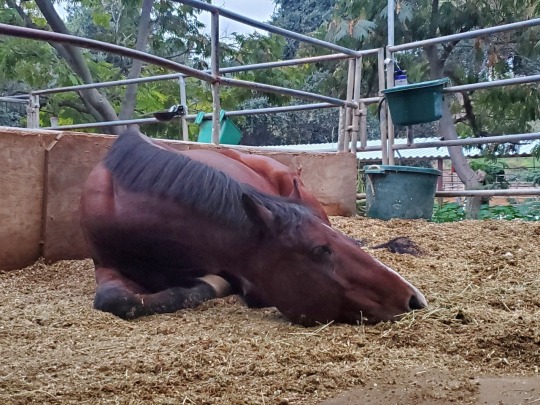
Whiskey takes a nap.
4 notes
·
View notes